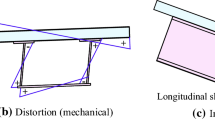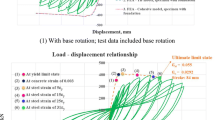Abstract
The horizontally curved continuous composite steel-concrete beams, for instance, curved continuous composite bridges, have excellent qualities, such as quick construction, good seismic performance, saving construction formwork and convenience in spatial arrangement etc. At present, the application research of this kind of structures is becoming more of a concern, but very few studies have been conducted to study the mechanical performance of composite beams subjected to combined hogging (negative) bending and torsion. The purpose of the present study is to investigate the effects of curvatures on both elastic and inelastic behaviours of curved continuous steel-concrete composite beams in the interior support regions. Based on the experimental observations in a straight composite beam, a three-dimensional FE model capable of analysing the composite beams subjected to negative bending moment is built. Further numerical studies on curved composite beams with different curvatures are performed in this study. Strength and load carrying capacity, sectional strain distribution and movement of composite neutral axis before and after cracking, as well as the strain results of longitudinal reinforcing bars are investigated. Besides, the interaction equation for ultimate bending and torsional moments is proposed.
Similar content being viewed by others
References
AASHTO LRFT (2007). AASHTO LRFD Bridge Design Specifications. American Association of State Highway and Transportation Officials, Washington, DC.
Awall, M. R., Hayashikawa, T., He, X., and Matsumoto, H. (2013). “Improvement effects of bottom lateral bracings on dynamic performance of curved steel twin I-girder bridges under running vehicles.” International Journal of Steel Structures, 13(2), pp. 275–290.
ACI 318-71 (1971). Building code requirement for reinforced concrete. American Concrete Institute, Detroit, pp. 78.
Dörr, K. (1980). Ein Beitrag zur Berechnung von Stahlbetonscheiben unter besonderer Berücksichtigung des Verbundverhaltens. Ph.D. thesis, University of Darmstadt (in German).
Hognestad, E. (1951). A study of combined bending and axial load in reinforced concrete members. University of Illinois Engineering Experiment Station, Bulletin Series.
Hu, S. and Nie, J. (2005). “Experimental study on interaction of flexure and torsion in composite steel-concrete beams.” Building Structure, 35(1), pp. 44–48.
Kasaeian, S., Azhari, M., Heidarpour, A., and Hajiannia, A. (2012). “Inelastic local buckling of curved plates with or without thickness-tapered sections using finite strip method.” International Journal of Steel Structures, 12(3), pp. 427–442.
Kim, K. and Yoo, C. H. (2006). “Ultimate strength interaction of bending and torsion of steel/concrete composite trapezoidal box girders in positive bending.” Advances in Structural Engineering, 9(5), pp. 707–718.
Kyung, K. S., Jeon, J. C., Lee, H. H., Lee, S. J., and Park, J. E. (2012). “Fatigue crack and its retrofitting method in a curved I girder bridge.” International Journal of Steel Structures, 12(4), pp. 563–578.
JSCE (2007). Standard specifications for steel and composite structures. Japan Society of Civil Engineers.
JSCE (2002). Standard specification for concrete structures-2002, Japan Society of Civil Engineers.
Lin, W. and Yoda, T. (2010). “Analysis, design and construction of curved composite girder bridges: state-of-the-art.” International Journal of Steel Structures, 10(3), pp. 207–220.
Lin, W. and Yoda, T. (2013). “Experimental and numerical study on mechanical behavior of composite girders under hogging moment.” International Journal of Advanced Steel Construction, 9(4), pp. 309–333.
Lin, W., Yoda, T., and Taniguchi, N. (2013a). “Fatigue tests on straight steel-concrete composite beams subjected to hogging moment.” Journal of Constructional Steel Research, 80, pp. 42–56.
Lin, W., Yoda, T., Kumagai, Y., and Saigyo, T. (2013b). “Numerical study on post-fracture redundancy of the twogirder steel-concrete composite highway bridges.” International Journal of Steel Structures, 13(4), pp. 671–681.
Lin, W., Yoda, T., Taniguchi, N., and Hansaka, M. (2013c). “Performance of strengthened hybrid structures renovated from old railway steel bridges.” Journal of Constructional Steel Research, 85, pp. 130–139.
Lin, W., Yoda, T., Taniguchi, N., Kasano, H., and He, J. (2014a). “Mechanical performance of steel-concrete composite beams subjected to a hogging moment.” Journal of Structural Engineering, ASCE, 140(1), 04013031.
Lin, W., Yoda, Y., Taniguchi, N, Satake, S., and Kasano, H. (2014b). “Preventive maintenance on welded connection joints in aged steel railway bridges.” Journal of Constructional Steel Research, 92, pp. 46–54.
Okada, J., Yoda, T., and Lebet, J. P. (2004). “A study of the grouped arrangement of stud connectors on the shear strength.” Journal of the Japan Society of Civil Engineers, 766, pp. 81–95.
Ollgaard, J. G., Slutter, R. G., and Fisher, J. W. (1971). “Shear strength of stud connectors in lightweight and normal weight concrete.” Engineering Journal of AISC, 8(2), pp. 55–64.
Nakasu, M. and Iwatate, J. (1996). “Fatigue experiment on bond between concrete and reinforcement.” Transaction of JSCE, 426, pp. 852–853.
Nie, J., Luo, L., and Hu, S. (2000). “Experimental study on composite steel-concrete beams under combined bending and torsion.” Composite and Hybrid Structures, 2, pp. 631–638.
Nie, J., Tang, L., and Cai, C. S. (2009). “Performance of steel-concrete composite beams under combined bending and torsion.” Journal of Structural Engineering, ASCE, 135(9), pp. 1048–1057.
Park, R. and Paulay, T. (1975). Reinforced concrete structures. John Wiley and Sons Inc., USA, pp. 346–391.
Tan, E. L. and Uy, B. (2009a). “Experimental study on straight composite beams subjected to combined flexure and torsion.” Journal of Constructional Steel Research, 65(4), pp. 784–793.
Tan, E. L. and Uy, B. (2009b). “Experimental study on curved composite beams subjected to combined flexure and torsion.” Journal of Constructional Steel Research, 65(8–9), pp. 1855–1863.
Wang, Y. C. (1998). “Deflection of steel-concrete composite beams with partial shear interaction.” Journal of Structural Engineering, 124(10), pp. 1159–1165.
Yoo, C. H. and Heins, C. P. (1972). “Plastic collapse of horizontally curved bridge girders.” Journal of Structural Division, ASCE, 98(St4), pp. 899–914.
Author information
Authors and Affiliations
Corresponding author
Rights and permissions
About this article
Cite this article
Lin, W., Yoda, T. Numerical study on horizontally curved steel-concrete composite beams subjected to hogging moment. Int J Steel Struct 14, 557–569 (2014). https://doi.org/10.1007/s13296-014-3013-x
Received:
Accepted:
Published:
Issue Date:
DOI: https://doi.org/10.1007/s13296-014-3013-x




